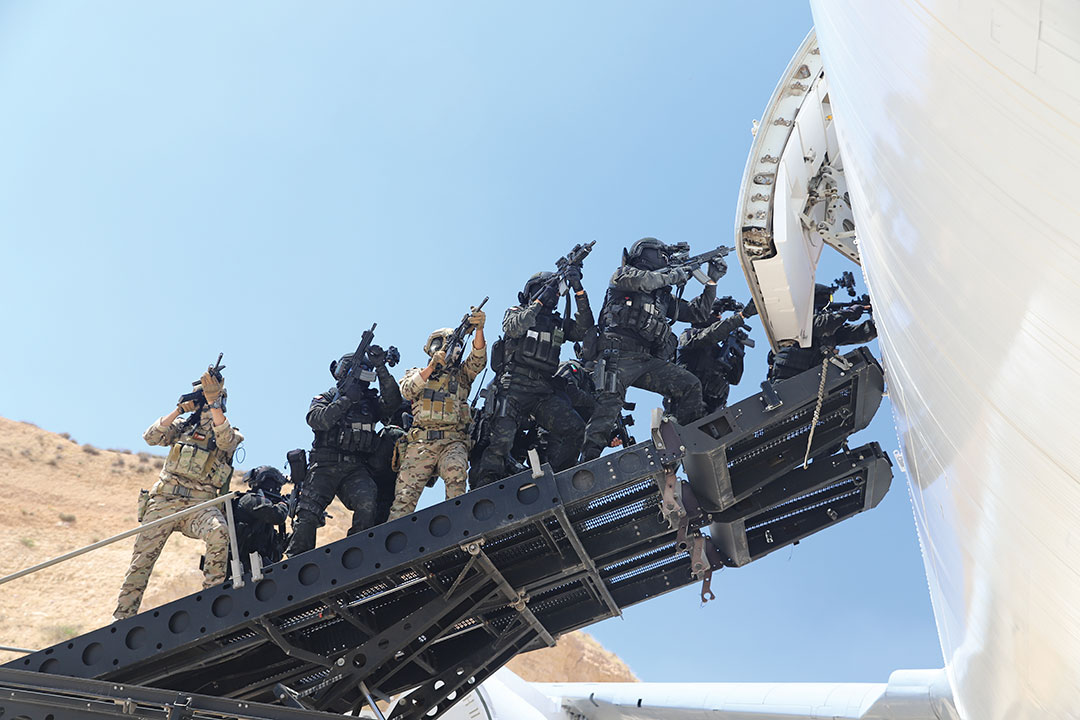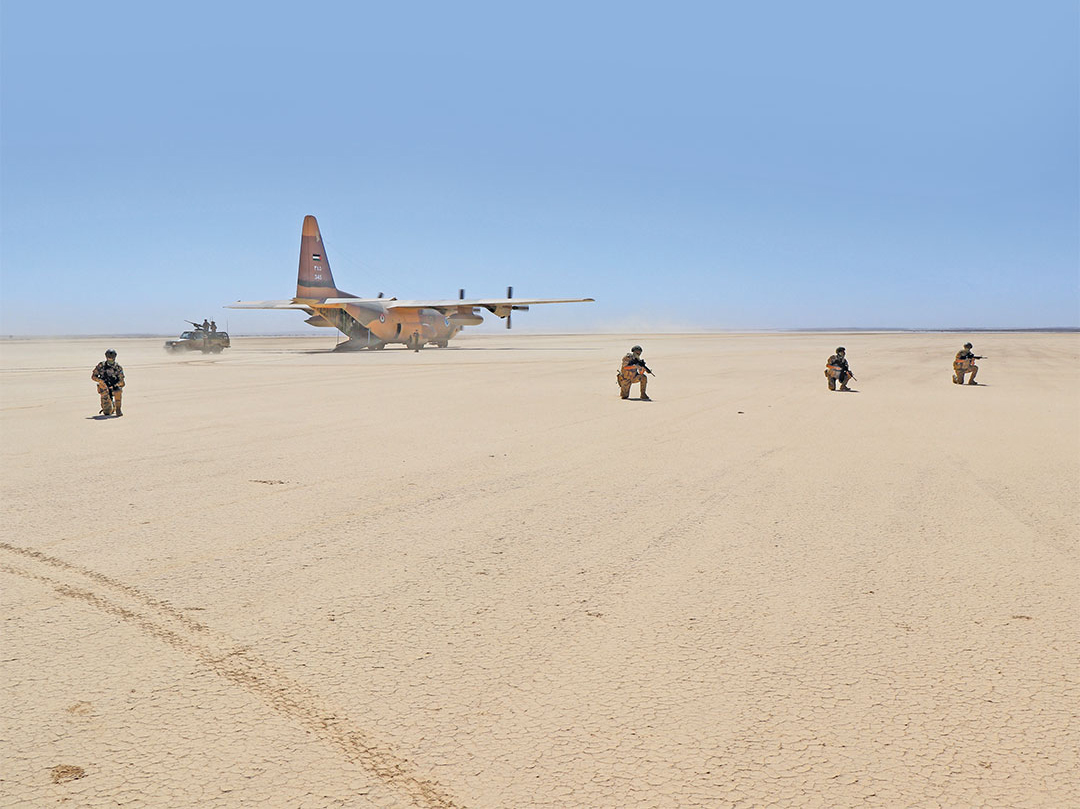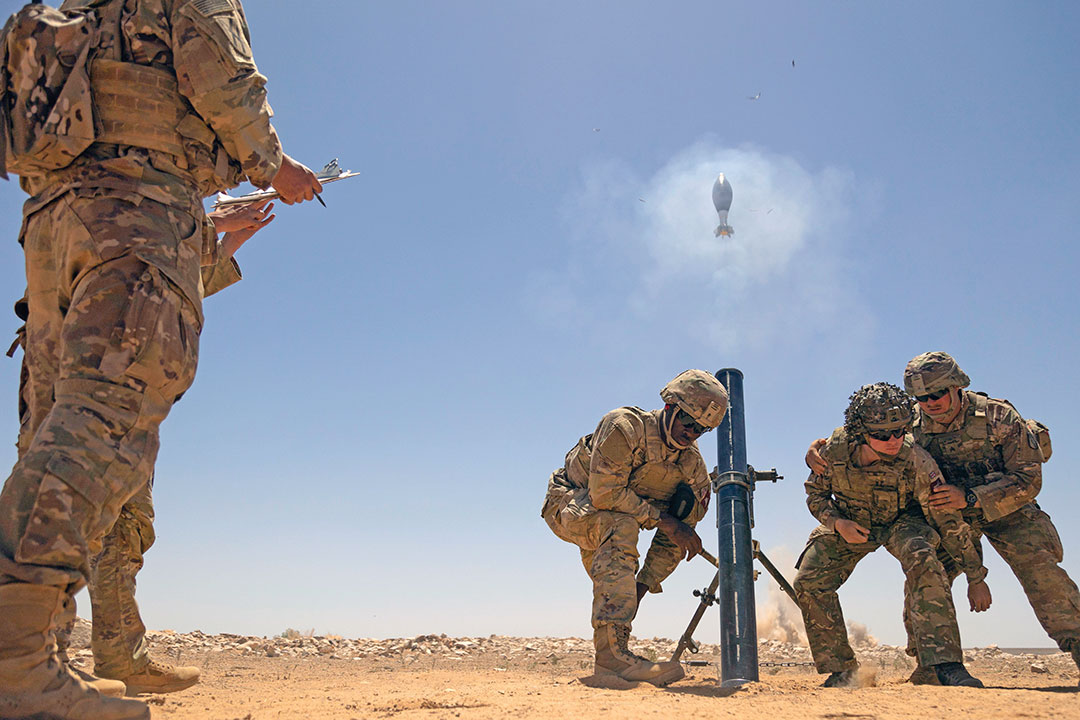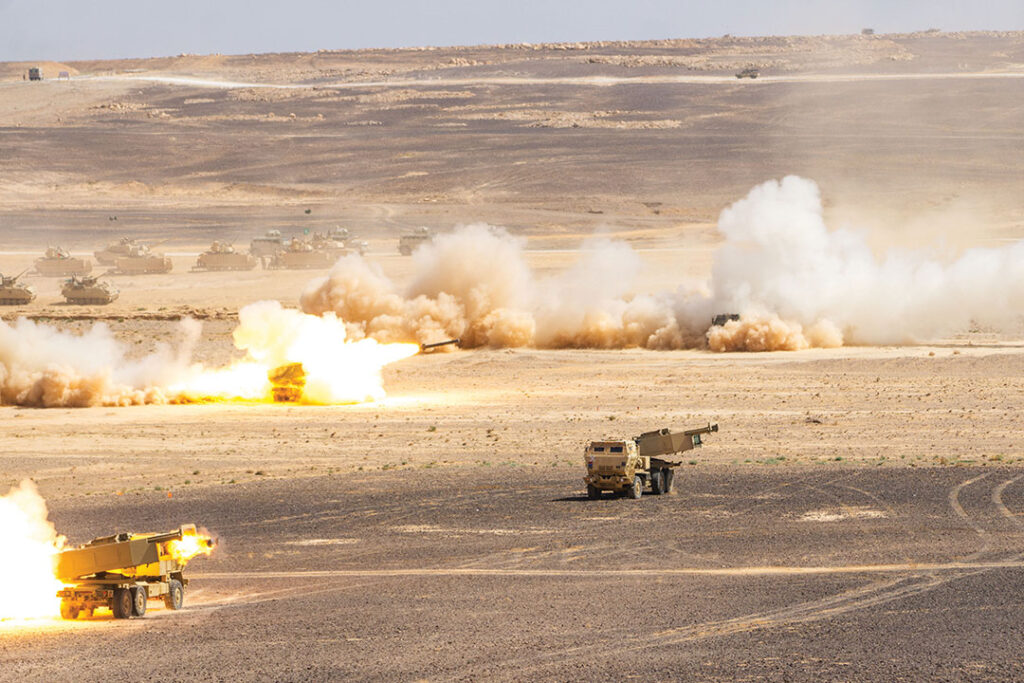In a remote training ground in central Jordan, multinational special operations forces dashed from an aircraft that had landed on a desert airstrip. Usually lightly equipped, these highly skilled, mobile troops arrived more heavily armed this time.
Emerging from the bellies of C-130 aircraft, the U.S.-made High Mobility Artillery Rocket System (HIMARS) added a powerful punch to these quick reaction forces.HIMARS platforms normally rumble on all-terrain wheels to reach launch position. But at Eager Lion 24, the military exercise that engaged forces from 33 countries in May 2024, the missile launchers benefited from rapid insertion on the battlefield by air.
This was the 11th time Jordan hosted Eager Lion, which attracted 3,800 troops bound together by common aims. Troops must be more agile. More integrated. More innovative and technologically skilled. More aware of contemporary threats to stability and security.
In addition to forces from Jordan and the United States, troops came from countries across the region
for the two-week exercise: Bahrain, Egypt, Iraq, Kazakhstan, Kuwait, Lebanon, Oman, Pakistan, Saudi Arabia, the United Arab Emirates
and Yemen.
“Eager Lion has been one of the major joint military exercises in the region for the training of the Jordan Armed Forces-Arab Army and participating allied forces to promote the exchange of military expertise, achieve cohesion in joint operations, and meet operational requirements,” said Brig. Gen. Hasan Al-Khalidi, then training director of the Jordan Armed Forces-Arab Army.

“Accelerating changes in the international, regional and local environments require leaders to have a deep understanding of the theater of operations, be prepared to deal with potential threats, comprehend the requirements of modern warfare, and emulate the latest developments in the arts of planning, training and combat.”
Events at Eager Lion 24 reflected the evolution of the modern battlefield in which troops must contend with disruptive technologies that are inexpensive, easy to use, widely available and sometimes unpredictable. Scenarios encompassed air, land, sea and cyber domains.
Countering unmanned aerial vehicles was a prime focus of drills at Training Area 5 in central Jordan. Jordanian and U.S. troops trained on portable jammers designed to scramble the navigation of drones before they could drop their lethal payloads.
Maritime training in the port of Aqaba introduced unmanned surface and underwater vehicles that have been transforming how navies and coast guards protect ships and coastal installations. Uncrewed vessels extend the sensor and photographic range of maritime forces and transmit millions of bits of information every day that artificial intelligence systems sort for relevance.
Disruptive technologies were among the topics discussed at Eager Lion’s Senior Leader Seminar. Jordan Armed Forces presenters briefed multinational colleagues on how adversaries use drones not just for terrorist attacks but also to smuggle drugs on the Jordanian-Syrian border.
In response, Jordan has trained hundreds of Soldiers from the Armed Forces to pilot surveillance and attack drones. After their integration into front-line and special operations units, these pilots have completed successful missions addressing real-world threats.

Senior officers from the region made a plea for improved cybersecurity to protect weapons systems that rely on computer guidance. Even as nations introduce unmanned, automated weapons systems, humans must remain in the loop to ensure they function as intended.
Head of the Iraqi delegation, Maj. Gen. Yaser Aziz, praised Eager Lion’s focus on building an integrated air defense system to thwart missiles and drones. Five senior officers from the Iraqi Ministry of Defense attended the exercise, helping fill the ranks of the multinational headquarters staff. The Iraqi Counter-Terrorism Service supplied an entire platoon for counterterrorism drills.
“We all remember with pride the honorable role of the Iraqi forces in liberating Iraqi lands from the abomination of terrorism,” Maj. Gen. Aziz said. “The participation was good for all participating friendly and allied forces.”
Eager Lion 24 created conventional and unconventional scenarios to which a multinational combined joint task force had to respond. Aside from countering new technologies wielded by adversaries, the exercise conducted a live-fire battlefield drill featuring tanks, attack helicopters and artillery, and enlisted Marines and Sailors to practice storming ports and seizing enemy vessels in Aqaba.
Eager Lion also hosted two counter-weapons of mass destruction events, one at the Joint Training Center in Zarqa and another in Aqaba. They focused on potential contamination by chemical and biological agents, and the training represented a coordinated response by military and civilian agencies.
Rotating teams of special operation forces from across the region performed counterterrorism drills at the King Abdullah II Special Operations Training Center (KASOTC). It served as the headquarters for special operations forces participating in Eager Lion. Jordanian, Saudi, Emirati, Lebanese, Iraqi and U.S. troops took target practice, raided mock villages, countered smuggling and rescued hostages.

“Great care goes into writing the scenarios and sequence of events to ensure that every participant will benefit, taking into account their particular needs and restrictions while striving to ensure that they return to their countries having added to their experiences or tool kits,” said Jordanian Lt. Col. Murad Altrwana, who oversaw field training at KASOTC for multinational forces at Eager Lion.
“I am always pleased to observe the level of professionalism and competence displayed by the participants. Everyone in attendance is eager to train, exchange skills and knowledge.”
Brig. Gen. Jason Benson, U.S. Central Command’s director for Eager Lion 2024, summed up the benefits of Eager Lion during an opening day speech at KASOTC.
“Eager Lion demonstrates the value of working together to maintain a ready and responsive force that truly demonstrates we are prepared to respond together in times of crisis,” Brig. Gen. Benson said.
“Participating in Eager Lion demonstrates our shared commitment to improving interoperability with our partners. It also demonstrates that our coalition force can maintain a sufficient and sustainable presence in the region. It delivers a clear message that relationships matter.”
War Against Narcotics on the Jordanian-Syrian Border
JORDAN ARMED FORCES-ARAB ARMY DIRECTORATE OF MILITARY INTELLIGENCE
Jordan’s northern border, afflicted since the start of the Syrian civil war by a surge in smuggling and illegal migration, is facing an intensifying crisis that requires international attention.
That crisis is caused by the manufacture of the illegal narcotic Captagon with the complicity of the Iranian and Syrian regimes in territory near the Jordanian border. Millions of these pills are subsequently smuggled internationally.
Jordan’s long border with Syria isn’t the only region to suffer from this illicit trade. The region as a whole feels repercussions from this developing security threat:
Syrian-manufactured Captagon causes addiction and other health problems for thousands of people throughout the region, straining medical services in various countries.
Captagon sales help finance malign activities, including violent extremism, by regimes and militias in the region.
Smuggling of the drug corrupts elements of government and society — including members of security services — that become complicit in the drug trade for financial gain.
Smuggling operations threaten national security as criminals seek soft spots along international borders. That includes drugs smuggled through seaports in such places as the Arabian Gulf.
Where manned border posts are more frequent — generally in the northwest corner of Jordan — smugglers are reluctant to risk arrest. More often, smugglers seek opportunities along our more remote desert border stretching eastward to Iraq.
Taking advantage of the border, nearly half of Syrian Captagon factories are within 30 kilometers of Jordan, reducing transportation costs for criminals. Smuggling networks operate more intensely along that same stretch of border, enlisting drones in their operations and occasionally provoking firefights with Jordanian troops.
To defend the border, Jordan has harnessed modern technology, often with the aid of foreign security partners. A border surveillance system designed to detect, identify, track and intercept smugglers and other criminals operates on much of the country’s 440-kilometer border with Iraq and Syria.
Use of surveillance drones and night-vision equipment is routine among Jordan’s Border Guard Forces. And the development of Quick Reaction Forces in the Jordanian military ensures that mobile, highly trained troops can reenforce vulnerable sections of the border as necessary.
Jordan does not rely solely on military and security efforts. Public services campaigns inform the public of the dangers of drug consumption. Diplomacy with the Syrian regime continues even if the drugs continue to flow from Syrian-based factories that produce an estimated 80% of the world’s Captagon.
As with countering terrorism, stopping illicit trafficking is a challenge that transcends the efforts of one nation. The increased scale of trafficking operations along the Jordanian border requires continued regional and international cooperation to deter it.

